 | E-mail to Birds Korea |
 | KWBS |
in the Region
 | The Oriental Bird Club |
 | BirdLife International (Asia) |
November
Waves of colder air cause a sharp drop in temperature, especially from mid-month onwards, when maxima can be as low as 8-10°C: the last of the autumn migrants are joined by huge numbers of wintering waterbirds.
Numbers of Baikal Teal continue to build, along with geese (many of which move on into China). Swan Geese peak at the Han-Imjin (with 1000-1500 in recent autumns). Common Buzzards and Cinereous Vultures start to arrive for the winter, along with gulls (Saunders's, Siberian, Vega, Mongolian and Slaty-backed are all widespread), Red-crowned, White-naped and Hooded Cranes, and passerines, including Siberian Accentor. Movements of divers and alcids, most especially Ancient Murrelet, can be impressive. Passerines include many late summer visitors until the second week of the month, when winter species, such as Chinese Penduline Tit and Pallas's Reed Bunting start to predominate.
Outstanding national rarities in November have included Black-headed and Ortolan Bunting and Savannah Sparrow on Gageo Island in 2000 and 2001, Demoiselle (2001) and Siberian White Crane in the Nakdong and the Han-Imjin/DMZ (2001) respectively, Korea's first White-capped Water Redstart and Water Pipit in 2003, the country's third and fourth Verditer Flycatchers in 2004, and a Ural Owl photographed at Odaeson National Park in 2005.
(The following records are a compilation of our own sightings and records sent in by other observers. As well as being posted on the Birds Korea website(s), selected records are also forwarded to other Korean-language birding websites; records of threatened species are arranged and forwarded to Birdlife International and national authorities when appropriate; flag images and records are passed to bodies responsible for their coordination throughout the flyway; and all records sent to us are used to compile annual reports and to support the evolving understanding of the status of many of Korea’s birds.)
Eungbong to Oksu and at Songnae (stream and river points in Seoul), November 27
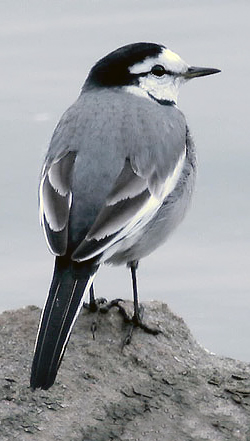
The stream between Eungbong and Oksu yielded good numbers of waterfowl: abundant Northern Pintail and Common Teal and slightly smaller numbers of Gadwall and Shoveler. A lugens White Wagtail preened on the rocks. Deeper water downstream (near the Han river) held Great Cormorants, about 60 Tufted Duck, and scattered Pochards.
At Songnae, the Han river held 3 distant Smew and a somewhat closer pair of Falcated Teal swimming with Spot-billed Ducks, and a pair of Kestrel hovered nearby.
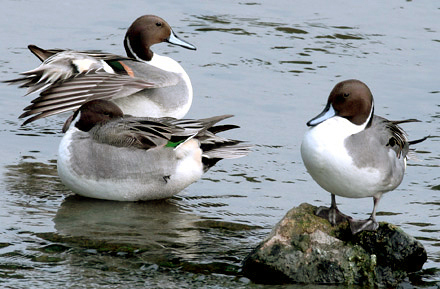
Yanggu, November 27
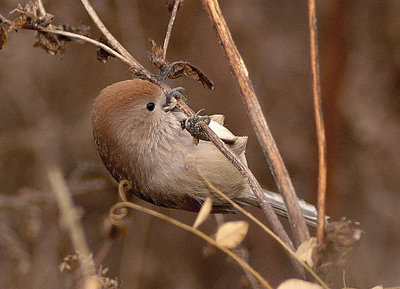
I wandered downstream along the river today and I was lucky enough to get some reasonable photos. A female Meadow Bunting (note the chestnut rump), a Vinous-throated Parrotbill, a Siberian Accentor, and a male Water Deer Hydropotes inermis argyropus.
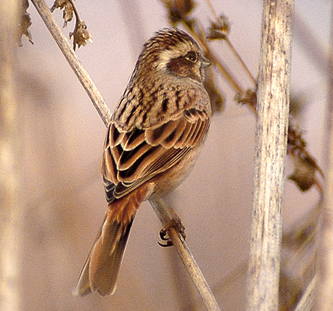
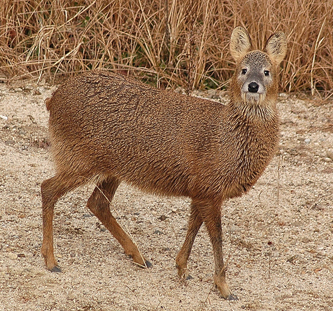
Keum Tidal Flats, Oh-seong Mountain, Ji-gok Dong canal, Kunsan Industrial Zone and Gunsan Reservoir, November 27
A White Spoonbill (JM) that was present on the 26th was absent today at the Geum Tidal Flats. However 250+ Eurasian Curlews were counted. Saunders' Gulls were present. A few Olive-backed Pipits were seen. Up river two huge groups of Baikal Teal were rafting. A pair of Mandarin Ducks were pointed out by PN. On Oh-seong Mountain a few Red-flanked Bluetails were seen, all apparently females. The industrial zone had a good assortment of Gulls: Heuglin's were there in equal if not greater number than Vega. One Slaty-backed Gull was noted. A couple of Common Gulls were in the mix.
The Gunsan reservoir had 17 or more Black-necked Grebes, an unusually high number for these parts.
In east Eunpa Park 80+ Azure-winged Magpies cautiously crossed a gap to get to their evening roost.
Joonam Lake, November 26
The weather was pleasantly sunny with minimal wind for a November day. I only visited 2 of the reservoirs (the main and the upper). The day brought most of the typical birds for this time of year, which include: Pintail, Coots, Gadwall, Pochard, Tufted Duck, Falcated Teal, 4 Eurasian Spoonbill, Great Egrets, Grey Heron, Little Egret, Bean Geese, Striated Heron, Greater Fronted Goose, 2 Great Cormorants, Mallards, Spot-billed Duck, Northern Shoveler, Common Teal, a couple of Eurasian wigeon, 2 Common Goldeneye, 1 Northern Lapwing, Bullheaded Shrike, Winter Wren, Yellow throated Bunting, Daurian Redstart, Great Tits, 2 Reed buntings, 1 Dusky Thrush, and a Peregrine Falcon. Near the end of my visit on the upper reservoir I came across 2 Japanese Quail, 1 large Sandpiper spp. (Redshank?) and most unexpectedly 1 PAINTED SNIPE. Unfortunately, my interest in the bird brought other undesirable attention and I was not able to get a "quality" picture.
Kokrungcheon, November 24
One Little Owl photographed. A Little Owl was seen in the same area on October 7th.
Keum Tidal Flats, November 20
A Hoopoe was seen flying over the tidal flats at the Keum and a Siberian Accentor was in a canal nearby.
Gangwon-do at Odaeson National Park, November 19 - 20
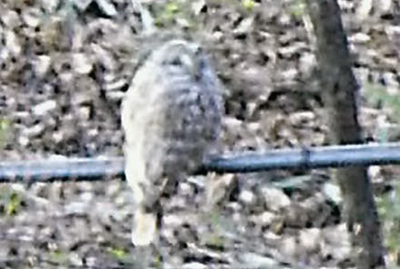
Photo © Sidra Blake
Birding wasn't as productive as hoped for. The mornings were less active than usual probably due to the lower temperatures. Eurasian Nuthatch were plentiful. Long-tailed Rosefinch, a Brown Dipper, and a Grey-headed Woodpecker were noticed.
Highlight was a Ural Owl.
[This appears to be only the sixth record for South Korea. There are four specimens listed in Park's 2002 thesis (2 from Gyeonggi in 1927 and 1928, and 2 from Gangwon Do, in 1975 and in 1992). There was a stunning photograph of one taken by Choi Soon-Kyoo in Gangwon Do, about 2 or 3 years ago - and now this one. Nial Moores].
Gangneung Arboreteum/Soomokgwan, November 17
Cool and sunny and fairly quiet -- in terms of both humans and birds! Highlights included 3 Winter Wrens, a Eurasian Nuthatch, Rustic and Yellow-throated Buntings, a Common Buzzard, a male Pheasant, and beautiful views of Great Spotted, Pygmy, and one (female) Black Woodpecker.
Gangwon-do, November 16
A distinctly cold day at the waterside was enlivened by a good representation of winter birds. No less than 6 Japanese Wagtails were spaced along the broad, gravelled river, as well as a pair of Long-billed Plovers, 1 Common Kingfisher, 1 Brown Dipper, and 3 Mandarin Duck.
Other typical waterbirds present included ca.20 Little Grebes, 2 Common Teal, 2 Goldeneye, Little and Intermediate Egrets, Mallards and Spot-billed Ducks.
In nearby scrub and woodland, a loose party of c.20 Varied Tits, 2 Siberian Accentors, several Yellow-throated and Rustic Buntings, 1 Meadow Bunting, an Oriental Greenfinch, 2 Bull-headed Shrikes, 12 Siskins, a European Nuthatch, Greater Spotted and Japanese Pygmy Woodpeckers, a Ring-necked Pheasant, and a Merlin passing quickly overhead.
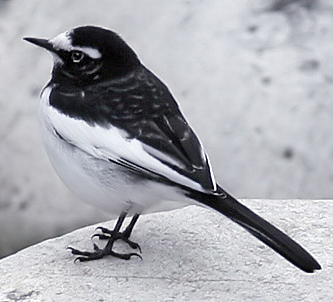
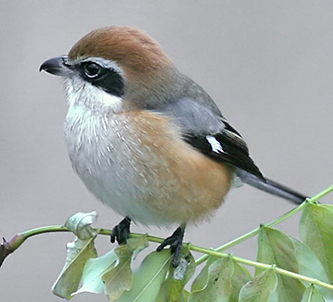
Geum River, Oh-seong Mountain, Man-gyeong and Gunsan vicinity, November 13
Long-billed Plovers were present in their Ji-gok Dong canal. There also, a rather late Grey Wagtail. A Siberian Accentor was in a canal near the Geum, with Black-faced Buntings were there as well. A pair of White-backed Woodpeckers was on Oh-seong Mountain (PN). A Pale Thrush was heard. Common Mergansers have appeared in small groups in several locations today. Eighty-five Whooper Swans were counted. Baikal Teals are in numbers difficult to count. Kang Jeong-hoon of the migratory bird observatory claims 300,000 were present this weekend.
At Hwoe-hyun on the Man-gyeong a Merlin was seen. Also there, two Peregrine Falcons sparred. A group of 25 White Spoonbills and a pair of juvenile Black-faced Spoonbills were observed. Also there, a pair of Black-winged Stilts. A single Spotted Redshank seems late. AZitting Cisticola was in the reeds.
Most significant for the day: in a copse of trees east of Eun-pa Park among a large group of mixed Tits a single Yellow-bellied Tit was watched well enough that it showed all its field marks. The bird had a strong double wing bar, a stripe up the nape, yellow extending from the belly up to or near the throat. It lacked any bib, but PN noted malar marks. It was observed at relatively close range.
(This is the second record for Korea, following the first on Socheong Island, October 22 2005, found by Nial Moores - see Latest Birds: October 2005.)
Upo Ramsar site, November 5 - 6
Warmer weather than usual occured on both Saturday(05) and Sunday (06). The night brought approx 9 hours of rain leading to a fog filled morning.
Waterfowl and shorebirds of great numbers included: Bean Goose, Coots, Spot-billed Duck, Mallard, Teal, and Dunlin. Others occurring in numbers lower than 100 were: Falcated Teal, Pintail, Eurasian Wigeon, Northern Shoveler, 4 Common Snipe, Northern Lapwing, 3 Greenshank, Common Sandpiper and 7 Eurasian Spoonbills.
Other species observed included: Olive backed Pipit, Bull headed Shrike, Daurian Redstart, Little Bunting, Yellow throated Bunting, Yellow browed bunting, Oriental Great Reed Warbler (heard), Rustic Bunting, and Common Kestrel.
Seosan, November 6
A fun day of good company and beautiful birds was enjoyed by all the attending Birds Korea members!
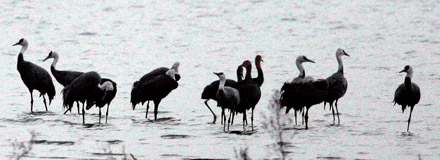
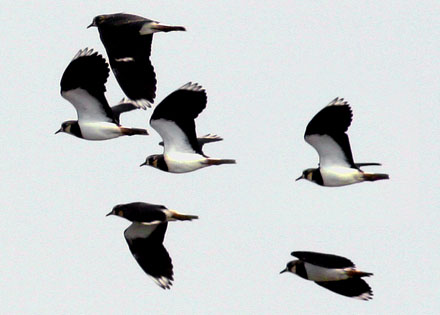
Seosan's first offering was a tightly packed raft of 200.000+ Baikal Teal, and a multitude of Greater White-fronted and Bean Geese in the rice fields, featuring 3 presumed Snow X Greater White-Fronted hybrids, 1 Lesser White-fronted Goose (heard), and 12 Northern Lapwing.
Raptors included great views of a Hen Harrier, 4 Common Buzzard, a Eurasian Sparrowhawk and a Peregrine terrorising the assembled waterfowl (with notably a Black-necked Grebe and at least 4 Goldeneye present).
Waders were still lingering in surprisingly good numbers: a Spotted Redshank and Green Sandpiper on the stream, with massed ranks of Dunlin (100+), Common Greenshank (20) and Great Knot (5+), some Grey Plover, Eurasian (15+) & Far Eastern Curlews (ca10), and a 3 Marsh Sandpiper (first November record?) and 2 Bar-tailed Godwit.
Sunset brought several hundred Ruddy Shelduck and 20 graceful Hooded Cranes to settle on the islands, a pretty sight indeed.
Many thanks to Kim Hyun Tae (who also saw both Upland Buzzard and Oriental White Stork today) for his help in assisting and guiding the group.
Yanggu, November 6
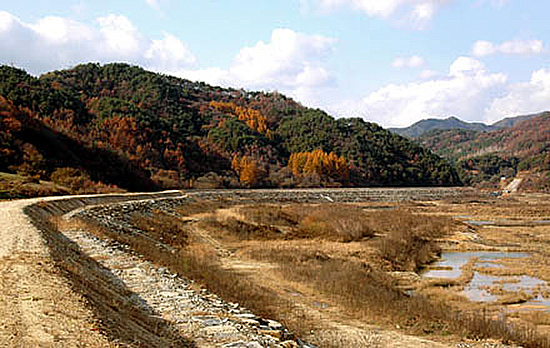
Small numbers of Long-tailed Rosefinches found feeding on seeds of a daisy-like plant along a dried-up river.
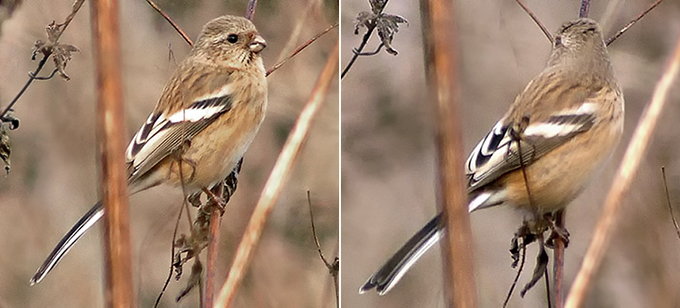
Han-Imjin/Cheorwon, November 5
An afternoon's birding produced ca 50 Rook and 8+ Daurian Jackdaw in Gimpo; ca 630 Swan Goose along with ca 50 White-naped and 3 Hooded Cranes on the Han-Imjin (where also one Cinererous Vulture); 3 Mandarin Duck, 7 Long-billed Plover, 5 Green Sandpiper and a Dunlin on a short stretch of river near Yeondeok; and ca 60 White-naped Crane in the Cheorwon basin.
In addition, probably ca 25 000 grey geese for the day, including one Lesser White-fronted Goose heard at Cheorwon, where also one white-winged and one largely grey (leucistic) White-fronted Goose.
Busan, November 4
Sadly, no sign of the Pheasant-tailed Jacana (though present until November 3 at the same site). Instead, best was a single Grey Thrush (very few autumn records, especially on the mainland).
Heuksan Island, November 4
Highlight was a winter-plumaged Water Pipit.
Jangsu Gun, November 3
Stunning views (and images) of an Alpine Accentor.
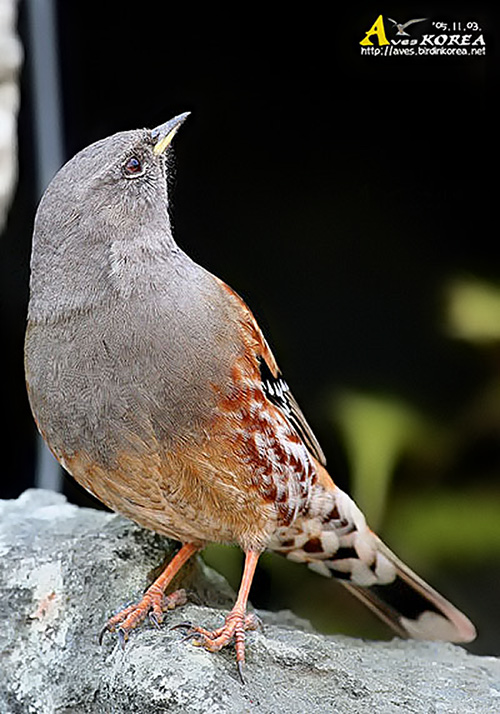
CheongGae Mountain, November 3
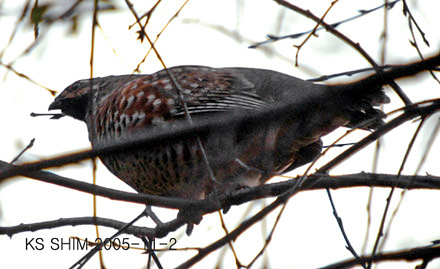
1 Hazel Grouse





